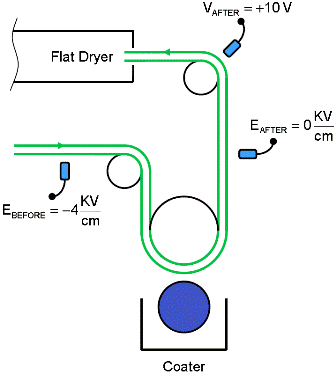Does Coating Neutralize Static?
- Published: April 02, 2012, By Kelly Robinson
 |
| Figure 1: The fieldmeter reveals static on the web before coating. After coating, the fieldmeter reading is zero. |
The goal is for our customers to unwind our products with no static problems. So, we need to wind products with no static. Why should we concern ourselves with static between the unwinder and the coater? After all, doesn’t coating neutralize static?
Figure 1 shows typical measurements. Fieldmeter reading EBEFORE shows static on the web from the unwinder entering the coater. The electric field EAFTER measured near the coated web is zero. So, surely the web is static free after coating.
However, the voltage VAFTER of the coated layer entering the dryer indicates static. So, let’s take a closer look.
 |
| Figure 2: Coating does not neutralize static on the backside. Opposite charges in coating balance backside static. |
Figure 2 shows the locations of the static. The web from the unwinder has negative static on the backside. Fieldmeters respond to the net charge, which is the sum of the charge on the front and back sides. So, EBEFORE responds to this negative charge on the backside.
Coating has no effect on the static charges on the backside. However, most coating solutions have some electrical conductivity. And, the coater is grounded, so the coating solution as applied is grounded.
When the web exits the coater, charge is induced in the conducting liquid that is equal in magnitude and opposite in sign to the charge on the uncoated side. The fieldmeter measurement EAFTER responds to the net charge, which is zero. The induced charge in the coated layer exactly balances the static on the backside. This is the results of coating ... balanced charge making EAFTER zero.
The voltmeter measurement VAFTER responds only to the charge on the exposed surface and confirms the magnitude and polarity of the charge induced in the coated layer.
So, we must concern ourselves with static charge on the web prior to coating. Specifically, we must work to neutralize the back surface of the web prior to coating.








